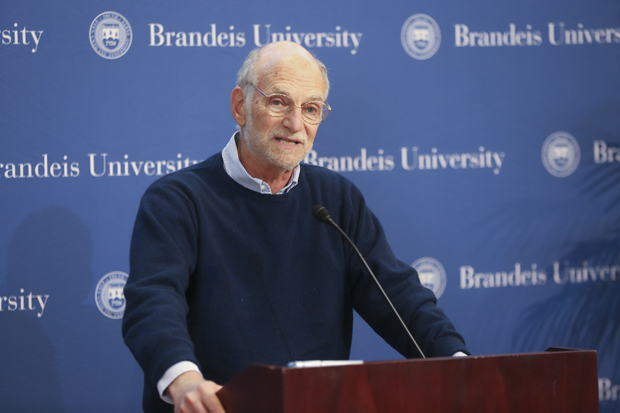How Rosbash and Hall did it
 Photo: Mike Lovett
Photo: Mike LovettRosbash at the press conference at Brandeis to recognize his award.
Michael Rosbash grew up in Boston, the son of German-Jewish immigrants. His father worked as a cantor, and his mother was a cytologist. He attended Caltech as an undergraduate and earned a PhD in biophsyics at MIT.
Jeff Hall spent his childhood in Bethesda, Maryland. His father was a star reporter for the Associated Press who covered the U.S. Senate and presidential races. Hall's high-school teachers in biology and chemistry sparked his interest in the sciences. He intended to be pre-med at Amherst College but found the students in the program unlikable and ruthlessly competitive. He switched his major to biology.
When Rosbash and Hall arrived at Brandeis in the 1970s, they were both 30 and became fast friends. They played pick-up basketball and shared a passion for sports and rock and roll.
One day at the gym, Hall mentioned that he was working on the per gene in fruit flies. “So let’s clone per,” Rosbash said. By 1984, they’d done it, using new techniques and technologies that were transforming genetics.
The next step was figuring out what per did. At a very general level, the gene functioned like any other. It bore the instructions for manufacturing a protein inside the cell. But what protein? And what was its function?
They soon discovered the PER protein and its remarkable dynamics. Its level peaked just before dawn, then dropped during the day so that by dusk, it was undetectable. The per gene functioned by keeping PER production on a 24-hour schedule.
Having achieved such key successes, Rosbash and Hall now worked relentlessly to identify other molecular processes driven by per. Their labs put in 12-hour days, six days a week. It was "a pretty intense emotional experience," said Kathy Siwicki, then a postdoctoral fellow in Hall’s lab. "We were working in uncharted territory."
The next breakthrough came when Rosbash and Hall discovered the messenger RNA (mRNA) molecule linked to the per gene. Messenger RNA carries the gene's instructions from the cell nucleus to the cytoplasm, triggering PER production. The scientists saw that mRNA levels rose and fell depending on the time of day. It peaked four to six hours before PER protein levels rose.
Rosbash saw a bigger picture emerging. He thought that the per gene, PER protein and RNA might be involved in a feedback loop. Soon he had constructed a fruit fly model.
First, the per gene set off production of mRNA.
Second, molecules of mRNA left the cell nucleus and set off production of PER protein.
Finally, when PER production peaked, PER molecules traveled back into the cell nucleus where they repressed their own synthesis and degraded. This decay caused the per gene to produce mRNA, starting the whole cycle again.
It was an amazing breakthrough, the one for which Rosbash and Hall would become renowned when they published the results in 1990. Nearly a decade's worth of work led to an understanding of the machinery that runs the internal biological clock in nearly all life. The molecular mechanisms of circadian rhythms had been discovered.
Categories: Research, Science and Technology





